New Products & Services
March 2023
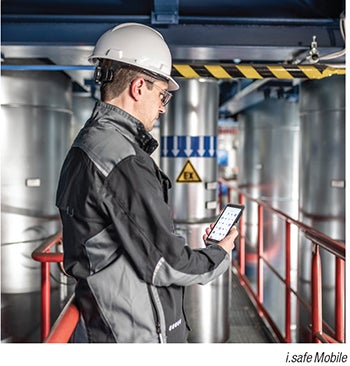 The IS540.1 (photo) is said to be the world’s first 5G smartphone for ATEX and IECEx zone 1/21. The intrinsically safe mobile device, which was also developed for use in 5G campus networks, offers extensive deployment scenarios ranging from predictive maintenance, augmented reality (AR) applications, control and cooperation of production robots and production lines, management of automated guided vehicles (AGVs), autonomous transport robots, remote monitoring and support to PTT video calls in the system area to prevent plant failures. The high-performance Qualcomm QCM6490 chipset, a large 6-in. display, 48-MP main camera, and standards such as Wi-Fi 6, Bluetooth 5.2 and NFC complete the Android 12 smartphone’s extensive feature package. — i.safe Mobile GmbH, Lauda-Koenigshofen, Germany
The IS540.1 (photo) is said to be the world’s first 5G smartphone for ATEX and IECEx zone 1/21. The intrinsically safe mobile device, which was also developed for use in 5G campus networks, offers extensive deployment scenarios ranging from predictive maintenance, augmented reality (AR) applications, control and cooperation of production robots and production lines, management of automated guided vehicles (AGVs), autonomous transport robots, remote monitoring and support to PTT video calls in the system area to prevent plant failures. The high-performance Qualcomm QCM6490 chipset, a large 6-in. display, 48-MP main camera, and standards such as Wi-Fi 6, Bluetooth 5.2 and NFC complete the Android 12 smartphone’s extensive feature package. — i.safe Mobile GmbH, Lauda-Koenigshofen, Germany
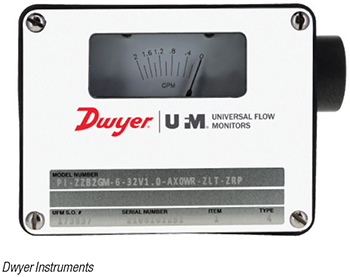 The new Series PI (photo) is a variable-area flowmeter that utilizes a spring-loaded piston. The fluid flow in the application causes this piston to move along the axis of a precision-tapered shaft, creating a variable orifice in direct proportion to the flowrate. The piston is mechanically linked to a readout pointer and actuates switches or a transmitter. Straight pipe runs are not required before or after the meter, allowing for installation in areas with minimal space. The three-wire version of the Series PI is equipped with a solid-state relay that can be configured in the field for alarm output. — Dwyer Instruments, LLC, Michigan City, Ind.
The new Series PI (photo) is a variable-area flowmeter that utilizes a spring-loaded piston. The fluid flow in the application causes this piston to move along the axis of a precision-tapered shaft, creating a variable orifice in direct proportion to the flowrate. The piston is mechanically linked to a readout pointer and actuates switches or a transmitter. Straight pipe runs are not required before or after the meter, allowing for installation in areas with minimal space. The three-wire version of the Series PI is equipped with a solid-state relay that can be configured in the field for alarm output. — Dwyer Instruments, LLC, Michigan City, Ind.
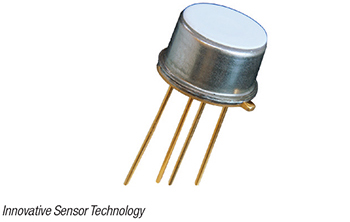 The HYT 939P temperature and humidity sensor (photo) is equipped with a PTFE filter, which makes it well-suited for industrial drying applications. The sensor’s compact housing allows for easy positioning within the monitored process, while the filter minimizes the influence of particulate matter and volatile organic compounds on the humidity sensor. The sensor is based on a capacitive-polymer measurement principle with a fast response time, low drift and hysteresis. The sensor remains stable in a high-humidity environment and can sustain condensation conditions. It comes fully calibrated and temperature-compensated. — Innovative Sensor Technology IST AG, Ebnat-Kappel, Switzerland
The HYT 939P temperature and humidity sensor (photo) is equipped with a PTFE filter, which makes it well-suited for industrial drying applications. The sensor’s compact housing allows for easy positioning within the monitored process, while the filter minimizes the influence of particulate matter and volatile organic compounds on the humidity sensor. The sensor is based on a capacitive-polymer measurement principle with a fast response time, low drift and hysteresis. The sensor remains stable in a high-humidity environment and can sustain condensation conditions. It comes fully calibrated and temperature-compensated. — Innovative Sensor Technology IST AG, Ebnat-Kappel, Switzerland
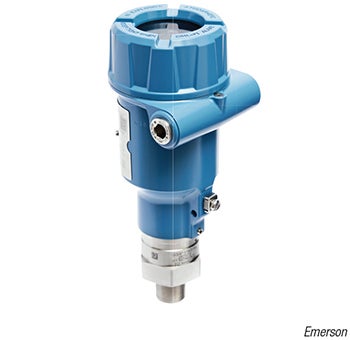 The Rosemount 3408 level transmitter (photo) is a non-contacting radar device designed to optimize ease-of-use, leading to increased safety and enhanced plant performance. While the benefits of radar level measurement are widely acknowledged, the company says radars are still sometimes perceived as being complex to commission, operate and maintain. Addressing this concern, the device provides a range of functions that reduce complexity throughout its lifecycle, including a highly intuitive interface, Bluetooth wireless technology remote capabilities, predictive alerts, in-situ verification, data historian and an upgradeable design. The user interface provides clear pictorial instructions, allowing operators to be easily guided through installation, commissioning, proof-testing, operation and maintenance. This increased ease-of-use gives process and manufacturing organizations the confidence to replace time-consuming manual procedures, thereby helping to increase safety and maximize productivity. — Emerson, St. Louis, Mo.
The Rosemount 3408 level transmitter (photo) is a non-contacting radar device designed to optimize ease-of-use, leading to increased safety and enhanced plant performance. While the benefits of radar level measurement are widely acknowledged, the company says radars are still sometimes perceived as being complex to commission, operate and maintain. Addressing this concern, the device provides a range of functions that reduce complexity throughout its lifecycle, including a highly intuitive interface, Bluetooth wireless technology remote capabilities, predictive alerts, in-situ verification, data historian and an upgradeable design. The user interface provides clear pictorial instructions, allowing operators to be easily guided through installation, commissioning, proof-testing, operation and maintenance. This increased ease-of-use gives process and manufacturing organizations the confidence to replace time-consuming manual procedures, thereby helping to increase safety and maximize productivity. — Emerson, St. Louis, Mo.
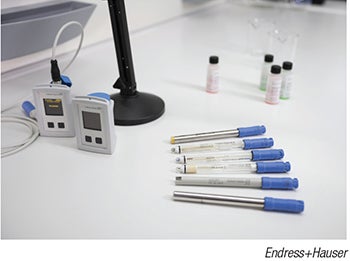 There are five new laboratory sensors (photo) that are compatible with this company’s Liquiline CML18 handheld laboratory analysis device. The Memosens CPL53E (digital pH sensor), CPL57E (digital pH sensor for low-conductivity water), CPL59E (pH sensor built for harsh conditions), COL37E (optical oxygen sensor) and CLL47E (four-electrode digital conductivity sensor) liquid analytical sensors now join the CPL51E to provide reliable measurement, easy operation and enhanced good laboratory practice (GLP). The new sensors support data and quality management in the verification processes of online measurements, provide immediate and tamper-proof calibration history traceability, with easy data transfer using Bluetooth technology. Using the bayonet connector, the handheld CML18 and Memosens sensors are plug-and-play devices, with support for easily switching output parameters — such as pH, dissolved oxygen and conductivity — at the measuring point. Users can begin making measurements without initial calibration since instruments are pre-calibrated at the factory. — Endress+Hauser, Greenwood, Ind.
There are five new laboratory sensors (photo) that are compatible with this company’s Liquiline CML18 handheld laboratory analysis device. The Memosens CPL53E (digital pH sensor), CPL57E (digital pH sensor for low-conductivity water), CPL59E (pH sensor built for harsh conditions), COL37E (optical oxygen sensor) and CLL47E (four-electrode digital conductivity sensor) liquid analytical sensors now join the CPL51E to provide reliable measurement, easy operation and enhanced good laboratory practice (GLP). The new sensors support data and quality management in the verification processes of online measurements, provide immediate and tamper-proof calibration history traceability, with easy data transfer using Bluetooth technology. Using the bayonet connector, the handheld CML18 and Memosens sensors are plug-and-play devices, with support for easily switching output parameters — such as pH, dissolved oxygen and conductivity — at the measuring point. Users can begin making measurements without initial calibration since instruments are pre-calibrated at the factory. — Endress+Hauser, Greenwood, Ind.
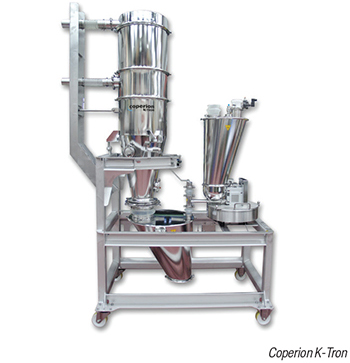 This company’s new batch-weighing system (photo) is designed for accurate batching direct to blenders or mixers. The station features a P100 batch-weigh receiver combined with a KT20 loss-in-weight twin-screw feeder, mounted on a collection hopper. The batch-weigh receiver combines a vacuum receiver with a reliable weighing system for batching of major ingredients. The resulting combination allows ingredients to be conveyed and weighed so that accurate batching of ingredients can take place on either a cumulative or sequential basis. The KT20 loss-in-weight twin-screw feeder can accurately add smaller amounts of high-value minor ingredients to the batch. Batch-weigh receivers are available in sizes from 30 to 1,000 L. — Coperion K-Tron, Salina, Kan.
This company’s new batch-weighing system (photo) is designed for accurate batching direct to blenders or mixers. The station features a P100 batch-weigh receiver combined with a KT20 loss-in-weight twin-screw feeder, mounted on a collection hopper. The batch-weigh receiver combines a vacuum receiver with a reliable weighing system for batching of major ingredients. The resulting combination allows ingredients to be conveyed and weighed so that accurate batching of ingredients can take place on either a cumulative or sequential basis. The KT20 loss-in-weight twin-screw feeder can accurately add smaller amounts of high-value minor ingredients to the batch. Batch-weigh receivers are available in sizes from 30 to 1,000 L. — Coperion K-Tron, Salina, Kan.
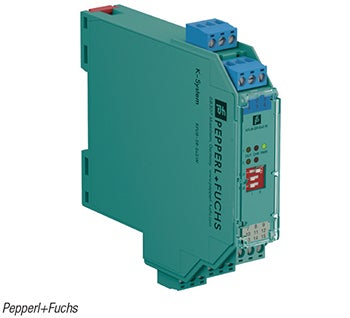 The new KFU8-SR-EX* (photo) is a universal powered switch amplifier that can be used in intrinsically safe applications and functional safety installations up to safety integrity level (SIL)2. The new KFU8 device can be supplied with 19 to 30 V d.c. or 90 to 253 V a.c. With this functionality, a single device can be used with various supply voltages. As a result, fewer components need to be kept in stock and in the field technician’s toolbox. The switch amplifiers transmit discrete signals from NAMUR sensors or mechanical contacts in the hazardous area to the safe area. A proximity sensor or switch controls the load on the control side via a changeover relay contact. All modules feature line fault detection. In the event of a fault, the relays de-energize and the fault is indicated by LEDs. — Pepperl+Fuchs, Inc., Twinsburg, Ohio
The new KFU8-SR-EX* (photo) is a universal powered switch amplifier that can be used in intrinsically safe applications and functional safety installations up to safety integrity level (SIL)2. The new KFU8 device can be supplied with 19 to 30 V d.c. or 90 to 253 V a.c. With this functionality, a single device can be used with various supply voltages. As a result, fewer components need to be kept in stock and in the field technician’s toolbox. The switch amplifiers transmit discrete signals from NAMUR sensors or mechanical contacts in the hazardous area to the safe area. A proximity sensor or switch controls the load on the control side via a changeover relay contact. All modules feature line fault detection. In the event of a fault, the relays de-energize and the fault is indicated by LEDs. — Pepperl+Fuchs, Inc., Twinsburg, Ohio
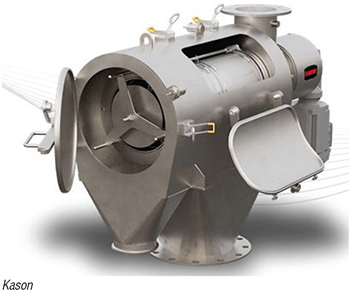 The Centri-Sifter M1 (photo) is a centrifugal sifter specially designed to help address the high costs associated with maintenance and recruiting, training and retaining skilled labor. The Centri-Sifter M1 sifts, scalps, de-agglomerates and dewaters granular materials ranging from dry bulk solids to solids-laden slurries. Centri-Sifter M1 is said to be the only centrifugal sifter on the market engineered for one-person operation and maintenance, which can help reduce the high cost of skilled labor. The Centri-Sifter M1 features a capacity of up to 15,000 lb/h of dry material and up to 50 lb/h of wet. — Kason Corp., Millburn, N.J.
The Centri-Sifter M1 (photo) is a centrifugal sifter specially designed to help address the high costs associated with maintenance and recruiting, training and retaining skilled labor. The Centri-Sifter M1 sifts, scalps, de-agglomerates and dewaters granular materials ranging from dry bulk solids to solids-laden slurries. Centri-Sifter M1 is said to be the only centrifugal sifter on the market engineered for one-person operation and maintenance, which can help reduce the high cost of skilled labor. The Centri-Sifter M1 features a capacity of up to 15,000 lb/h of dry material and up to 50 lb/h of wet. — Kason Corp., Millburn, N.J.
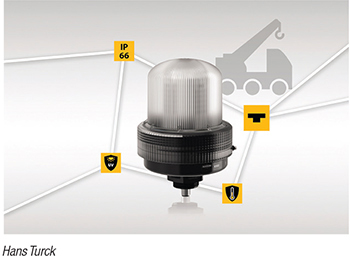 This company is expanding its portfolio of light-emitting diode (LED) lights with the robust LED indicators of the K100 series (photo). The 100-mm beacons — developed by partner company Banner Engineering — are available in two configurations. The Pro Daylight Visible beacon model offers 12 audible options and has a clear lens that avoids false indications, even in sunlight. It offers bright indication in both indoor and outdoor environments. It features three color options (green, yellow and red) for status indication, operator guidance and other functions. The K100 Pro Indicator model has a diffused lens that appears white when inactive, thereby preventing false indication. It features 14 color options that can be used for status and indication. Both beacon models can include an optional audible alarm and have an IP66 environmental rating. — Hans Turck GmbH & Co. KG, Mülheim an der Ruhr, Germany
This company is expanding its portfolio of light-emitting diode (LED) lights with the robust LED indicators of the K100 series (photo). The 100-mm beacons — developed by partner company Banner Engineering — are available in two configurations. The Pro Daylight Visible beacon model offers 12 audible options and has a clear lens that avoids false indications, even in sunlight. It offers bright indication in both indoor and outdoor environments. It features three color options (green, yellow and red) for status indication, operator guidance and other functions. The K100 Pro Indicator model has a diffused lens that appears white when inactive, thereby preventing false indication. It features 14 color options that can be used for status and indication. Both beacon models can include an optional audible alarm and have an IP66 environmental rating. — Hans Turck GmbH & Co. KG, Mülheim an der Ruhr, Germany